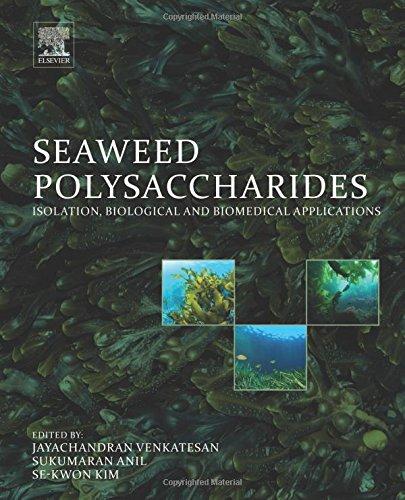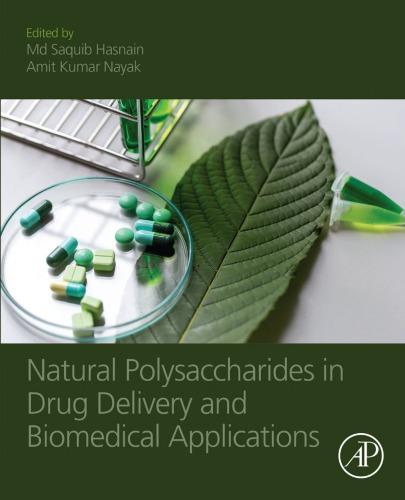Rehm
Visit to download the full and correct content document: https://ebookmass.com/product/biopolymers-for-biomedical-and-biotechnological-appl ications-bernd-h-a-rehm/

More products digital (pdf, epub, mobi) instant download maybe you interests ...

Algal Biotechnology: Integrated Algal Engineering for Bioenergy, Bioremediation, and Biomedical Applications
Ashfaq Ahmad
https://ebookmass.com/product/algal-biotechnology-integratedalgal-engineering-for-bioenergy-bioremediation-and-biomedicalapplications-ashfaq-ahmad/

Titanium Alloys for Biomedical Development and Applications: Design, Microstructure, Properties, and Application Zhentao Yu
https://ebookmass.com/product/titanium-alloys-for-biomedicaldevelopment-and-applications-design-microstructure-propertiesand-application-zhentao-yu/

Nanoparticles for Biomedical Applications: Fundamental Concepts, Biological Interactions and Clinical Applications 1st Edition Eun Ji Chung (Editor)
https://ebookmass.com/product/nanoparticles-for-biomedicalapplications-fundamental-concepts-biological-interactions-andclinical-applications-1st-edition-eun-ji-chung-editor/

Silicon Carbide Biotechnology, Second Edition: A Biocompatible Semiconductor for Advanced Biomedical Devices and Applications Stephen Saddow Ph.D
https://ebookmass.com/product/silicon-carbide-biotechnologysecond-edition-a-biocompatible-semiconductor-for-advancedbiomedical-devices-and-applications-stephen-saddow-ph-d/

Biological Macromolecules: Bioactivity and Biomedical Applications Amit Kumar Nayak
https://ebookmass.com/product/biological-macromoleculesbioactivity-and-biomedical-applications-amit-kumar-nayak/

Graphene Quantum Dots: Biomedical and Environmental Sustainability Applications Mohammad Oves
https://ebookmass.com/product/graphene-quantum-dots-biomedicaland-environmental-sustainability-applications-mohammad-oves/

Advanced Sensor Technology: Biomedical, Environmental, and Construction Applications Ahmed Barhoum
https://ebookmass.com/product/advanced-sensor-technologybiomedical-environmental-and-construction-applications-ahmedbarhoum/

Seaweed polysaccharides : isolation, biological and biomedical applications 1st Edition Anil
https://ebookmass.com/product/seaweed-polysaccharides-isolationbiological-and-biomedical-applications-1st-edition-anil/

Natural polysaccharides in drug delivery and biomedical applications Hasnain
https://ebookmass.com/product/natural-polysaccharides-in-drugdelivery-and-biomedical-applications-hasnain/
BiopolymersforBiomedicalandBiotechnologicalApplications
BiopolymersforBiomedicaland BiotechnologicalApplications
Editedby
BerndH.A.Rehm
M.FataMoradali
Editors
Dr.BerndH.A.Rehm
CentreforCellFactoriesand Biopolymers
GriffithInstituteforDrugDiscovery MenziesHealthInstituteQueensland GriffithUniversity DonYoungRoad,Nathan,QLD4111 Australia
Dr.M.FataMoradali DepartmentofOralImmunologyand InfectiousDiseases UniversityofLouisville UnitedStates
Allbookspublishedby Wiley-VCH arecarefullyproduced.Nevertheless, authors,editors,andpublisherdonot warranttheinformationcontainedin thesebooks,includingthisbook,to befreeoferrors.Readersareadvised tokeepinmindthatstatements,data, illustrations,proceduraldetailsorother itemsmayinadvertentlybeinaccurate.
LibraryofCongressCardNo.: appliedfor
BritishLibraryCataloguing-in-Publication Data
Acataloguerecordforthisbookis availablefromtheBritishLibrary.
Bibliographicinformationpublishedby theDeutscheNationalbibliothek
TheDeutscheNationalbibliotheklists thispublicationintheDeutsche Nationalbibliografie;detailed bibliographicdataareavailableonthe Internetat <http://dnb.d-nb.de>.
©2021WILEY-VCHGmbH,Boschstr. 12,69469Weinheim,Germany
Allrightsreserved(includingthoseof translationintootherlanguages).No partofthisbookmaybereproducedin anyform–byphotoprinting, microfilm,oranyothermeans–nor transmittedortranslatedintoa machinelanguagewithoutwritten permissionfromthepublishers. Registerednames,trademarks,etc.used inthisbook,evenwhennotspecifically markedassuch,arenottobe consideredunprotectedbylaw.
PrintISBN: 978-3-527-34530-4
ePDFISBN: 978-3-527-81828-0
ePubISBN: 978-3-527-81830-3
oBookISBN: 978-3-527-81831-0
CoverDesign Adam-Design,Weinheim, Germany
Typesetting SPiGlobal,Chennai,India PrintingandBinding
Printedonacid-freepaper 10987654321
Contents
1AdvancesinBiocompatibility:APrerequisiteforBiomedical ApplicationofBiopolymers 1 MatthewR.Jorgensen,HelinRäägel,andThorS.Rollins
1.1Introduction 1
1.2BiocompatibilityEvaluationofBiopolymericMaterialsandDevices 2
1.3UsingaRisk-BasedApproachtoBiocompatibility 4
1.3.1ChemistryofBiopolymersandRisk 6
1.3.2ChemistryScreeningofBiopolymers 7
1.4SpecificBiologicalEndpointEvaluations 11
1.4.1Cytotoxicity 11
1.4.2SystemicToxicity(Acute,Subacute,Subchronic,andChronic) 12
1.4.3Implantation 14
1.5Conclusion 15 References 16
2AdvancedMicrobialPolysaccharides 19 FilomenaFreitas,CristianaA.V.Torres,DianaAraújo,InêsFarinha, JoãoR.Pereira,PatríciaConcórdio-Reis,andMariaA.M.Reis
2.1Introduction 19
2.2FunctionalPropertiesandApplicationsofMicrobial Polysaccharides 20
2.3CommerciallyRelevantMicrobialPolysaccharides:EstablishedUses andNovel/ProspectiveApplications 22
2.3.1Pullulan 22
2.3.2Scleroglucan 23
2.3.3XanthanGum 23
2.3.4Dextrans 24
2.3.5Curdlan 24
2.3.6GellanGum 24
2.3.7Levan 25
2.3.8HyaluronicAcid 25
2.4HydrogelsBasedonMicrobialPolysaccharides 25
2.5BionanocompositesBasedonMicrobialPolysaccharides 29
2.6BioactivePolysaccharidesfromMicroalgae:AnEmergingArea 32
2.6.1Polysaccharide-ProducingMicroalgae 33
2.6.2BiologicalActivityandPotentialApplications 33
2.6.2.1AntiviralActivity 36
2.6.2.2Immunomodulatory,Anti-inflammatory,andAnticancer Activities 36
2.6.2.3AnticoagulantandAntithromboticActivity 38
2.6.2.4AntioxidantActivity 38
2.6.2.5OtherBiologicalProperties 39
2.6.3CommercializationProspects 39
2.7ApplicationsofChitinousPolymers 40
2.7.1Chitin,Chitosan,andChitinousPolysaccharides 40
2.7.2PropertiesofChitinousPolysaccharides 41
2.7.3ApplicationsofChitinousPolysaccharides 41
2.7.3.1BiomedicalApplications 42
2.7.3.2PharmaceuticalApplications 43
2.7.3.3FoodApplications 43
2.7.3.4OtherApplications 43
2.8MicrobialPolysaccharides:AWorldofOpportunities 44 Acknowledgments 45 References 45
3MicrobialCellFactoriesforBiomanufacturingof Polysaccharides 63
M.FataMoradaliandBerndH.A.Rehm
3.1Introduction 63
3.2ProminentMicrobialPolysaccharidesandTheirPropertiesand Applications 63
3.2.1XanthanandAcetan 64
3.2.2SuccinoglycanandGalactoglucan 64
3.2.3SphinganPolysaccharides 66
3.2.4Pullulan 66
3.2.5CelluloseandCurdlan 67
3.2.6Alginates 67
3.2.7HyaluronicAcidorHyaluronate 68
3.2.8Dextrans 68
3.2.9LevanandInulin 69
3.3BiosynthesisPathwaysofBacterialPolysaccharides 69
3.3.1GeneticBackgroundRequiredforBiosynthesisofPolysaccharidesin Bacteria 70
3.3.2ProductionofActivePrecursor,Polymerization,andPolysaccharide Modifications 71
3.3.3RegulatoryPathwaysandPosttranslationalModifications 72
3.4StrategiesforEngineeringCellFactories 76
3.4.1EnhancementofProductivityupontheEnergeticStateoftheCelland Metabolites 77
3.4.2GeneticandMetabolicEngineeringofCellFactories 78
3.4.3StrategiesforOptimizingPhysicochemicalPropertiesof Polysaccharides 79
3.4.4RecombinantProductionofPolysaccharidesandTailor-Made Products 83
3.5ConclusionandFuturePerspective 86 Acknowledgments 87 References 87
4ExploitationofExopolysaccharidesfromLacticAcid Bacteria 103
TsudaHarutoshi
4.1Introduction 103
4.1.1LacticAcidBacteria 103
4.1.2Exopolysaccharides 103
4.1.3ImportanceofPSProducedbyLAB 105
4.2Homo-PS 105
4.2.1Biosynthesis 105
4.2.2CompositionandStructure 106
4.2.3InstabilityofHomo-PSProduction 106
4.3Hetero-PS 111
4.3.1Biosynthesis 111
4.3.2MonosaccharidesCompositionofHetero-PS 111
4.3.3YieldofHetero-PS 112
4.3.4InstabilityofHetero-PSProduction 116
4.4PrebioticActivity 117
4.4.1CommercialPrebioticOligosaccharides 117
4.4.2PrebioticPolysaccharides 118
4.4.3PrebioticsinJapaneseFOSHU 119
4.4.4PrebioticsProducedbyLAB 119
4.5Conclusion 120 References 120
5Nanocellulose:ANewBiopolymerforBiomedical Application 129
HippolyteDurand,MeganSmyth,andJulienBras
5.1TrendsofBiobasedPolymersinBiomedicalApplication 129
5.1.1IntroductiontoBiomedicalEngineering 130
5.1.2OverviewofBiobasedMaterialsforBiomedicalApplications 132
5.1.2.1Biomaterials:ADefinition 132
5.1.2.2BiobasedPolymers 135
5.1.2.3CelluloseasaBiomaterial 138
5.2Nanocellulose:Production,Characterization,Application,and CommercialAspects 142
5.2.1IsolationandCharacterizationofNanocelluloseMaterials 143
5.2.1.1CelluloseNanocrystals 144
5.2.1.2CelluloseNanofibrils 145
5.2.1.3BacterialNanocellulose(BNC) 149
5.2.2CharacterizationofCellulosicNanomaterials(CNMs) 151
5.2.3IndustrializationofNanocellulose:FirstandUpcoming Applications 153
5.2.4HealthandToxicology:AConcernforCNMDevelopmentin BiomedicalField 154
5.2.5CelluloseNanofibrilsandMedicalApplications 164
5.3ConclusionsandPerspectives 170 References 170
6AdvancesinMucinBiopolymerResearch:Purification, Characterization,andApplications 181 MatthiasMarczynski,BenjaminWinkeljann,andOliverLieleg
6.1Introduction 181
6.2MucinSourcesandPurificationProcess 182
6.3Structure–FunctionRelationofMucins 185
6.4CharacterizingMucinsandMucin-BasedMaterials 187
6.5BiomedicalApplicationsofPurifiedMucins 190
6.5.1EyeDropsorContactLensCoatings 190
6.5.2MouthSprays 192
6.5.3ArtificialJointFluids 192
6.5.4CoatingsofMedicalDevices 193
6.5.5ComponentsofHydrogelsforDrugDelivery 194
6.5.6MolecularStandardsforLabTestswithClinicalMucusSamples 194
6.6Outlook:EngineeredMucinsandMucin-MimeticPolymers 194 Acknowledgments 195 References 195
7AdvancesintheSynthesisofFibrousProteinsandTheir Applications 209
GangWei,XiMa,YaruBai,CoucongGong,andYantuZhang
7.1Introduction 209
7.2Synthesis,Structure,andCharacterizationsofFibrousProtein Materials 210
7.2.1SynthesisMethods 210
7.2.2Structure 212
7.2.3Characterizations 213
7.3ApplicationsofFibrousProteinMaterials 213
7.3.1BoneTissueEngineering 213
7.3.2BiomedicalEngineering 215
7.3.3SensorsandBiosensors 216
7.3.4Nanodevices 217
7.3.5EnergyApplication 218
7.3.6EnvironmentalApplication 220
7.4Conclusions 223 Acknowledgments 224 References 224
8MicrobialPolyhydroxyalkanoates(PHAs):FromSynthetic BiologytoIndustrialization 231
YukiMiyahara,AyakaHiroe,ShunsukeSato,TakeharuTsuge, andSeiichiTaguchi
8.1Introduction 231
8.2SyntheticBiologyforProductionofKanekaPHBH 233
8.2.1IsolationofBacteriumProducing Poly(3-hydroxybutyrate-co-3-hydroxyhexanoate) 233
8.2.2MaterialPropertiesofPHBH 234
8.2.3IndustrialPHBHProductionProcess 235
8.2.4MolecularBreedingofPHBH-ProducingBacteria 236
8.2.5PreciseControlof3HHxFractionbyGeneticModificationof Ralstoniaeutropha238
8.2.6BusinessPlanforKanekaPHBHIndustrialization 239
8.3SyntheticBiologyforProductionofMedium-Chain-LengthPHAswith HomogeneousSide-ChainLengths(Homo-PHAs) 240
8.3.1CopolymersBasedonMedium-Chain-LengthPHAMonomeric Constituents 240
8.3.2PathwayEngineeringforHomo-PHAProduction 242
8.3.3ImprovedMicrobialProductionofHomo-PHAs 243
8.3.4MaterialPropertiesofHomo-PHAs 245
8.3.5IntegratedProductionProcessofHomo-PHAsfromRenewable Feedstock 246
8.4SyntheticBiologyforProductionofLactate-BasedPolymers 247
8.4.1CreationofLactate-PolymerizingEnzyme(LPE) 247
8.4.2BiosynthesisofLactate-BasedPolymers 249
8.4.3IntegratedProductionProcessofLactate-BasedPolymersfrom RenewableFeedstock 251
8.4.4BiosynthesizedLactate-BasedPolymerShowsSuperior Properties 253
8.5Outlook 254 References 255
9NaturalandSyntheticBiopolymersinDrugDeliveryandTissue Engineering 265
JohnD.Schneible,MichaelA.Daniele,andStefanoMenegatti
9.1Introduction 265
9.2SyntheticandNaturalSubstrates 267
9.3ApplicationsofNaturalandSyntheticPolypeptides 267
9.3.1DrugDeliveryVehicles 267
9.3.2TargetingAgents 273
9.3.3Cell-PermeatingPeptides 274
9.3.4PeptidesinTissueEngineeringandRegenerativeMedicine 276
9.4ApplicationsofPolysaccharides 280
9.4.1DrugDelivery 280
9.4.2TissueEngineeringandRegenerativeMedicine 284
9.5ConclusionsandFutureOutlook 290 References 290
x Contents
10BiopolymersinRegenerativeMedicine:Overview,Current Advances,andFutureTrends 357
MichaelR.BehrensandWarrenC.Ruder
10.1Introduction 357
10.2BiopolymerScaffoldAssembly 358
10.2.1HydrogelBiopolymerScaffolds 358
10.2.2ElectrospinningofBiopolymerScaffolds 360
10.2.3Three-DimensionalPrintingofBiopolymerScaffolds 362
10.3OrganSystemSpecificBiopolymerScaffolds 367
10.3.1BiopolymersforMusculoskeletalSystemRegeneration 368
10.3.1.1BiopolymersforBoneRegeneration 368
10.3.1.2BiopolymersforCartilageRegeneration 370
10.3.1.3BiopolymersforLigamentandTendonRegeneration 371
10.3.2BiopolymersforCardiovascularSystemRegeneration 372
10.3.2.1BiopolymersforVascularRegeneration 373
10.3.2.2BiopolymersforCardiacRegeneration 374
10.4SummaryandOutlook 376 References 377
Index 381
AdvancesinBiocompatibility:APrerequisiteforBiomedical ApplicationofBiopolymers
MatthewR.Jorgensen,HelinRäägel,andThorS.Rollins
NelsonLaboratories,LLC,6280SRedwoodRd,SaltLakeCity,UT84123,USA
1.1Introduction
Biocompatibilityisaconceptthat,inoneformoranother,hasexistedsincethe dawnofmedicine.AtthebaseofVesuviusinancientRomewasthehouseof asurgeon,hometoanimpressivecollectionofmedicalinstrumentsthatwere preservedbyashwhenthemountainexploded.Withoutadoubt,patronsofthe ancientsurgeonsubjectedthemselvestothesedeviceswiththeexpectationand trustthattheywouldbegettingbetter–notworse–duetothetreatmentthey received.Whilebiocompatibilityhasnotalwaysbeenexplicitlydefinedthrough history,thesafetyofatoolinadoctor’shandiscentraltothemissionofthedoctor. Followingtheindustrialrevolution,instrumentshavebecomemass-produced andmarketedaseffectivetoolsforthepracticeofmedicine,makingdoctorsrely onthediligenceofthemanufacturertoensurepatientsafety.Concurrently,our knowledgeoftoxicologyhasexpandedthroughexperience,andmedicaljournals havebecomewidelyavailabletoshareclinicalexperiences.Theseplatformshave beenandarecurrentlysuccessfullyusedtonotifydoctorsandalsothepublic aboutmedicalinstrumentsthoughttobesafe,butwhichactuallydidmoreharm thangood,anddiscussoptionsformitigatingtherisksassociatedwiththeuseof thesedevices.
Toprotectpatientsfrombeingharmedbymedicaldevices,whichforonereasonoranothermightbeunsafeduetonegligenceonthepartofthedevicemanufacturer,medicaldevicesafetyhasbecomeregulated.Theseregulationsrequire medicaldevicemanufacturersmakingadeviceorproducttodemonstratethat whattheyareproducingperformsappropriatelywhenusedasintended.Past experienceandmoderntoxicologyhaveidentifiedwhatsortsofhealthrisksare associatedwiththeuseofagivenmedicaldevice.Themostmodernandcomprehensiveoverviewofbiocompatibilityisthesuiteofdocumentsthatmakeupthe internationalstandardISO10993;thefirstdocumentintheseries, ISO10993-1, providesthehigh-levelframeworkforevaluationofbiocompatibilityasawhole, whiletheotherdocumentsintheseriesexplorespecifictopicsinmoredetail.
Themodernconceptanddefinitionofbiocompatibilityistheabilityofamedicaldevice(ormaterial)to“performwithanappropriatehostresponse”when BiopolymersforBiomedicalandBiotechnologicalApplications, FirstEdition. EditedbyBerndH.A.RehmandM.FataMoradali. ©2021WILEY-VCHGmbH.Published2021byWILEY-VCHGmbH.
1AdvancesinBiocompatibility:APrerequisiteforBiomedicalApplicationofBiopolymers usedasintended.Thismeansthatthedeviceormaterialshouldnotcausean unacceptablebiologicalriskwhenused,takingintoaccountthenatureofusein termsofcontactsiteandduration,aswellasthepotentialbenefitofusingthe device.ISO10993-1,AnnexA,listsseveralkeybiologicalrisksassociatedwith specifictypesanddurationsofpatientcontact.Asthecontactdurationgoesup, andthedevicesormaterialsbecomemoreinvasive,thetypesofpotentialrisks multiply.Forexample,adevicethatisusedonanintactskinisnotveryinvasive,andthereforetheassociatedrisksareminimal;theskinisanorganeffective atprotectingthebodyfromournaturalenvironmentthatisoftenrepletewith biologicalrisks.Incontrast,consideraneurologicalstent;thisinvasivedevice isinpermanentcontactwithbraintissues.Forsuchadevice,risksrangefrom immediatetoxicitytothrombosistomorechronicsystemictoxicitieslikecancer. Therefore,eventhemoremodernconceptofbiocompatibilityencompassesthe broaderideawellcapturedbytheoft-repeatedphraseinmedicine“First,dono harm,”whichcertainlyappliestothematerialsusedwiththeintentionofhealing.
1.2BiocompatibilityEvaluationofBiopolymeric MaterialsandDevices
Biopolymersrepresentaspecialsubsetofmaterialsusefulinmedicine,being derivedorproducedbylivingorganismsorsynthesizedfrombasicbiological buildingblocks.Comparedwithsyntheticpolymers,theadvantagesfromtheperspectiveofbiocompatibilityareclear:becausethesematerialsaremadebyliving systems,frombuildingblocksubiquitoustolife,itwouldseemlikethepotential foradversebiologicalreactionswouldbereduced.Forimplants,likebiocompositeboneanchorsusedbyArthrex® inhiparthroscopyprocedures(Figure1.1), ifthegoalistomimicthetissuebeingreplaced,usingamaterialmadefrom

Figure1.1 BioCompositeKnotless SutureTak® anchorusedinhip arthroscopyprocedures. Source: CourtesyofArthrex®.
1.2BiocompatibilityEvaluationofBiopolymericMaterialsandDevices 3
naturalbuildingblocksislogical.Thescopeandrangeofbiopolymershasbeen discussedindetailwithinthistextandelsewhereinliterature[1–3].Briefly,they includepolysaccharides(suchaschitin,hyaluronicacid,andcellulose),polyesters (suchaspolylacticacid[PLA]),proteins(suchassilk,collagen,andcasein),and otherslikelatexrubberandshellac.Asvariedasthepossiblebiopolymersare theirindividualchemicalproperties;therefore,broadgroupingofbiopolymers forbiocompatibilityisnotpossible.Rather,thesematerialsshouldbeconsideredwithoutspecialallowance,intermsoftheirintendeduseanddurabilityin thebody.
Thebiocompatibilityevaluationprocess,ingeneral,beginsbydetermining whatpotentialbiologicalriskstheuseofthematerialwouldpresent.Oncerisks aredetermined,aplantoevaluatethoserisksshouldbedeveloped.Often,the riskidentificationprocessbeginsbyansweringthefollowingquestions:
1. Whatistheintendeduseofthedevice(ormaterial)?
a.Whattissuesorfluidswillitcontactinthebody(eitherdirectlyorindirectly)?
b.Howlongisthecumulativeamountoftimeitmaycontactthebody?
c.Whowillbeexposedtothedevice(infants,pediatrics,adults)?
2. Whatisknownaboutthedevicematerialsandtheirfateinthebody?
a.Whatprocessing,packaging,andsterilizationarethematerialsexposed to?
b.Arethematerialsknowntodegradeovertime?
c.Whatpreviousclinicalexperienceistherewiththedevice(ormaterials)?
AnnexAinISO10993-1containsachartofbiologicalrisksforconsideration,stratifiedbycontactduration(limited ≤24hours,prolonged >24hoursto 30days,longterm >30days)andcontacttype.Theseriskscanprovideastarting pointforunderstandingtheriskspresentedbyadeviceforboththedevicemanufacturerandthosewhowouldintheendapprovethedeviceforuse.Toillustrate howAnnexAisused,twocommonlyusedbiopolymericdevicesareputthrough thethoughtprocessasexamples:
• Device1:Achitin-basedhemostaticagentforacutetreatmentduringmassive hemorrhageinanopenwound
• Device2:Apolycaprolactone(PCL)implantforinfants,designedtodegrade andresorboveraperiodoftwotothreeyears
HowthedescriptionofDevice1andDevice2translatesintoaclassification andsetofbiologicalrisksisshowninTable1.1.
TherisksidentifiedbyISO10993-1,AnnexA(outlinedforthetwodevicesin Table1.1),arenotnecessarilyall-inclusiveorexhaustive.Thespiritofthedocumentistoprovideastartingpointandbasisforabiologicalevaluation;ifother potentialbiologicalortoxicologicalrisksareknownthroughclinicalexperience, thosewouldalsoneedtobeaddressed.Forinstance,ifamedicalinstrumentis knownorhasbeenshowntochipduringasurgicalprocedure,leavingfragments ofthedevicepossiblypermanentlyinthepatient,thisshouldbeaddressedinthe biocompatibilityassessment.
1AdvancesinBiocompatibility:APrerequisiteforBiomedicalApplicationofBiopolymers
Table1.1 Exampleclassificationandassociatedrisksfortworepresentativedevices.
HemostaticImplant
ContacttissuesBleedingwoundMuscleandbone
ContactdurationExpectedtobelessthan 24h,butcouldextend beyond
Deviceresorbsover2–3yr
TargetpatientpopulationAdultsInfants
ClassificationperAnnexACategory:surfacemedical device
Contact:breachedor compromisedskin
Contactduration: prolonged
Biologicalriskstobe addressed(perISO 10993-1,AnnexA)
• Cytotoxicity
• Sensitization
• Irritation
• Material-mediated pyrogenicity
• Acutesystemictoxicity
• Subacutetoxicity
• Implantationeffects
Category:implantmedical device
Contact:tissue/bone
Contactduration: permanent
• Cytotoxicity
• Sensitization
• Irritation
• Material-mediated pyrogenicity
• Acutesystemictoxicity
• Subacutetoxicity
• Subchronictoxicity
• Chronictoxicity
• Implantationeffects
• Genotoxicity
• Carcinogenicity
• Degradation
ItshouldalsoberecognizedthattherisksidentifiedbyAnnexAarenothighlightedinthestandardasanexplicit“checklistfortesting.”Fortunately,thelatest ISO10993-1releasedin2018moreclearlydefinesthisstatementwithinthedocument.Basedontheupdatedverbiageinthestandard,eachofthebiologicalrisks (orendpoints)canbeevaluatedusingarisk-basedapproach,takingintoconsiderationchemicalandmaterialinformation,existingendpoint-specificdata,ora writtenrationalewhytestingorfurtherdataisnotneededtoaddressaparticularrisk.Inanycase,thebiocompatibilityofadeviceormaterialmustbespelled out,addressingdirectlyeachofthespecificriskidentified,mitigatingconcern throughtestingresultsorwrittenevaluationinabiologicalriskassessment.
1.3UsingaRisk-BasedApproachtoBiocompatibility
Afterthespecificbiologicalrisksforaparticularimplementationofadevice areidentified,thestrategyforhowthebiologicalsafetywillbeprovenmustbe decided.Inthepast,theexpectationwasthatbecausedevicesaretypicallymade bycompetitorsinuniqueenvironments,andwithproprietaryprocessing,categoricallycallingamaterial“biocompatible”wasnotpossible,andtestingshould beexecutedanewforeachdevicecomingtomarket.Thelistofbiologicalrisks
1.3UsingaRisk-BasedApproachtoBiocompatibility 5 wasprettymuchashoppinglist,moreorlessblindlyorderedandexecuted.Since thattime,therehasbeenadramaticshifttowardamorethoughtfulscientific approachtotheevaluationofbiocompatibility.
Theshiftfromcheck-listingteststoarisk-basedapproachhasbeenmotivated byseveralfactors:
• Considerationofanimalwelfare,withachargetoreduceanimaltestingas muchaspossible
• Abroaderandbetterconsolidatedbodyofdataonmaterialsandtoxicology
• Betteranalyticalchemistrytoolstoevaluatemanufacturingresiduals,material leachables,anddegradationproducts
Knowingthatthekeyistoprotectpatientsafetybyprovingbiocompatibility ofadevicetotheskepticalreviewerwhileatthesametimeavoidingasmuch unnecessarytestingaspossibleistheheartofevaluatingbiocompatibilityusing arisk-basedapproach.Thereisanarttoabiocompatibilityevaluation,balancingcommonsensemeasurestoensuresafetywithcurrentlyavailabledataon onehandandtheexpectationsofregulatorybodiesacrossthespectrumonthe other.Understandingtherolethematerialinformationhasandhowthisbroadly impactsthetestingstrategy(alongwiththecostandtimeburdenoftesting)is centraltothestrategy.
Inthebestcase,materialinformationandwrittenassessmentalonecanbesufficienttomitigateandaddressallofthebiologicalrisksassociatedwithadevice. Tobeconvincing,however,agreatdealofdetailisneeded.Often,thequestion ofbiocompatibilityisnotaboutthebulkmaterialitselfatall,butratheraboutthe processingofthatmaterialthattakesplacebothupstreamanddownstream.Considerapolycaprolactone(PCL)implant,manufacturedusing3Dprintingfrom apowderstartingmaterial.Tothemanufacturer,thenamePCLalongwithits assignedchemicalabstractsservice(CAS)numberdefinesthematerial.Butthere aremanywaystosynthesizePCL[4]thatmayinfluenceitssafetyprofileinterms ofimpuritiesthat(whilenotobviousfrombulkproperties)willaffecttoxicology. ConsiderthePCLpipelineupstreamfromthedevicemanufacturer:
1.Preparationofthemonomer(either ��-caprolactoneor6-hydroxycaproicacid) atrawchemicalsupplier:
a. ��-Caprolactoneand6-hydroxycaproicacidmaybeproducednaturally byoxidationofcyclohexanolbymicroorganismsandthenharvestedand purified(allstepsremovingorintroducingimpuritiestovaryingdegrees).
b. ��-Caprolactonecanalsobeproducedindustriallythroughareactionof cyclohexanonewithperaceticacid.
2.Themonomerispurified,packaged,sold,andshippedtothemakerofthe polymerwithoutknowledgethatthemonomerwillendupinamedical device:
a.Purityandperformancemetricsarebasedonbulkproperties(nottoxicologicalendpoints).
3.Themonomerispolymerizedbyanothermanufacturer:
a.Polymerizationoccursusingavarietyofdifferentpossibletechniques, usingdifferentactivatorsand/orcatalysts,severalofwhicharecomplex
1AdvancesinBiocompatibility:APrerequisiteforBiomedicalApplicationofBiopolymers organometalliccomplexesofquestionablesafety(see,forexample,those containedinRef.[4]).
4.Thepolymerispowderedandpurifiedbythemanufacturerusingaproprietary cryogenicprocess.
Most(orall)ofthedetailsoftheupstreamprocessareunknowntothemedical devicemanufacturer,yettheycanimpactdevicesafety.Itcouldmatter,froma toxicologicalperspective,ifthePCLinadeviceismanufacturedusinglithium diisopropylamideor tert -butoxypotassiumasacatalyst.Ifthedevicemanufacturerweretoasktheirpolymersupplierwhatcatalystorwhatmonomerisused andthemethodofmanufacture,theinformationislikelyconsideredintellectual property,andmedicaldevicemanufacturersaretypicallynotbigenoughcustomersofpolymermanufacturerstobeabletomakedemands.Therefore,inthese cases,itisuptothedevicemanufacturertoprovethebiocompatibilityoftheir materialsacknowledgingthatverylittleisknownabouttheimpurityprofileof theirdevice.
Knowingwhatyoudonotknowandhowthatgapinknowledgemightbeinterpretedbyaregulatororapatientreceivingthedeviceiskeyindevelopinga testingstrategyforbiocompatibility(Figure1.2).Regulatorshavebeenwitnessto allsortsofmischiefonthepartofmanufacturers,andpatientshavebeeninjured bydevicesmadefrommisunderstoodmaterials,elevatingfurthertheconcern foreachdevicethatisintheprocessofclearanceformarket.Forbiopolymer devices,itistypicallynotknownwhattracechemicalsmaybeinthematerial. Anothergapinknowledgeisoftenhowdifferentprocessingstepsinfluencethe degradationrateofresorbablebiopolymers.Toanswerthosequestions,weturn tochemistry.
1.3.1ChemistryofBiopolymersandRisk
Basedontheirphysicochemicalproperties,variousbiopolymerssofarusedin themedicalindustrycanlooselybeplacedintothreecategories:polysaccharides, proteins,andpolyesters.Someexamplesofcommonbiopolymersareshownin Table1.2. Intended use of device
Figure1.2 ThoughtprocessforusingISO10993-1forbiologicalevaluationofmedicaldevices.
Table1.2 Examplesofcommonbiopolymers.
ClassificationExamplebiopolymerNotesonproductionRisks
PolysaccharidesHyaluronicacid,HA (polymerof d-glucuronicacidand N -acetylglucosamine)
Primarilyproduced usingbacteria including Streptococcus [5–7]
Cellulose(polymerof d-glucose)
ProteinsSilk
Primarilyfibroin,a repeatingaminoacid sequenceof(Gly-SerGly-Ala-Gly-Ala)
Fromplantproducts, celluloseisdissolved fromotherplant materialsinanalkali process,followedby purification.Produced bacteriallyusing Acetobacterxylinum [8,9]
Primarilyfromthe mulberrysilkworm Bombyxmori [10]
PolyestersPolylacticacidPrimarilyring-opening polymerizationof lactide(cycliclactic aciddimer)[11]
Productionby pathogenicbacteria coproducesmyriad otherpotentiallytoxic biologicalproductsthat mustberemoved duringsubsequent purificationsteps
Industrialpurification stepscanintroduce impurities.Bacterial productioncoproduces myriadother potentiallytoxic biologicalproductsthat mustberemoved duringsubsequent purificationsteps
Industrial post-processingand purificationstepscan introduceimpurities
Crudelacticacid containsmany impurities(acids, alcohols,metals)
Whilethechemistryofbiopolymersandthesourceofthesematerials’buildingblocksareverydiverse,thereisacommonalityamongthemwhenitcomesto potentialpatientrisk:thereisalwaysconcernoversideproductsandmanufacturingresiduals.Whileitisacceptedthatbiopolymershaveaninherentadvantage frombeingsimilarchemicallytosubstancesnaturallyfoundinthebody,theyalso havethesamedisadvantagefacingallmedicaldevicematerialsfrombeingprocessed.Forthatreason,thechemicalevaluationstrategyusedformedicaldevices madefrombiopolymersisverysimilartowhatisusedfordevicesmadefromfully syntheticmaterials.Theheartofthestrategyisacknowledgingthatthemanufacturerofthedevicedoesnotknowwhattheydonotknow,andtheonlyway tosafeguardagainstunpleasantsurprisesistoscreenforeverythingthatmight reasonablybeinoronthedevice.
1.3.2ChemistryScreeningofBiopolymers
Itisimportanttostartthedesignofachemistrytestingstrategywiththeendgoal inmind.Inthecaseofchemistryforbiocompatibility,theendgoalistobeable toscreenforunexpectedcontaminantswithenoughsensitivityandwithenough
Sensitivity of analysis

Quality of identification
Breath of analysis needed
Chemical characterization: VOC, SVOC, NVOC, elemental impurities
Figure1.3 Importantaspectsforsettingupachemicalcharacterizationstudy.
accuracythattoxicologicalconclusionscanbemadebasedonthedataproduced (Figure1.3).Determiningthepropersensitivitycanbeamatterofdebatebut shouldbelowenoughsothatanychemicalsthatarepresent–butnotreported becausetheyarebelowthesensitivity–areknowntonotbetoxicologicallyconcerning.Inotherwords,athresholdoftoxicologicalconcern(TTC)isneeded.
TheTTCconceptwasdevelopedtodefineanacceptableintakeforany unstudied/understudiedchemicalthat,ifbelowtheTTC,wouldposeanegligibleriskofcarcinogenicity,systemictoxicity,andreproductivetoxicity.The conceptwasdevelopedforchemicalspresentinthehumandietandisaccepted bytheUSFoodandDrugAdministration(FDA),InternationalConference onHarmonization(ICH),andtheEuropeanMedicinesAgency(EMA)forthe evaluationofimpuritiesinpharmaceuticals.Ithasalsobeenusedforassessing contaminantsinconsumerproductsandenvironmentalcontaminants.The methodsuponwhichtheTTCisbasedaregenerallyconsideredveryconservativesincetheyinvolvedataforthemostsensitivespeciesandmostsensitive siteinduction(several“worst-case”assumptions).TheTTCconceptprovidesan estimateofsafeexposuresvaluesforanycompoundnotontheTTCexclusion list(i.e.metals,nitrosamines,andpolycyclicaromatichydrocarbons).Themost conservativeTTCvaluehasbeensetat1.5 μg/dandisassignedforgreaterthan 10yearstoalifetimeofexposure.ATTCof120 μg/dhasbeenproposedfor genotoxicexposureslimitedtoonemonthorless[12].ExceedingtheTTCisnot necessarilyassociatedwithanincreasedriskgiventheconservativeassumptions employedinthederivationoftheTTCvalue[13–17].Whenadequateevidence existsthataconstituentisnon-carcinogenic,anon-carcinogenicTTCvaluemay beusedtoaddresstheconstituent(e.g.Cramerclassification)[18,19].
TheTTCconceptformedicaldeviceswasformalizedinISO21726publishedin February2019.Thisbriefinternationalstandardoutlinestheappropriatestrategy forusingtheCramerclassandTTC.Whenadequatetoxicologicaldataisnot availableintheliterature,theCramerclassificationshouldbeusedfornon-cancer
Table1.3 RecommendedTTCvaluesfromISO21726.
Medicaldevice contactcategory Limited (<24h) Prolonged (24hto30d) Longterma) (>30d)
Durationofbody contact ≤1mo >1–12mo >1–10yr >10yrto lifetime
TTCforanyone compound(μg/d)
a)ConsideredpermanentaccordingtoISO10993-1.
b)Thisvalueincorporatesa10 5 cancerriskfora60kgadult.
effects;forcancer-basedeffects,theICHM7TTCvaluesshouldbeusedbased onthecontactdurationofthedevice.Cramerclassificationstratifiescompounds intothreegroups(I,II,andIII,withIIIbeingthehighestrisk);theacceptabledaily exposuresare1800 μg/dforclassI,540 μg/dforclassII,and90 μg/dforclassIII compounds.TheTTCvaluesfromISO21726forcarcinogenicendpointsdepend oncontactdurationandareshowninTable1.3.
Inadditiontothesensitivity,thebreadthoftheanalysisiscritical.ISO 10993-12,ISO10993-17,andISO10993-18provideguidanceonthesample preparationandscopeofanalysistogivetherequiredbreadth.Thedevice shouldbeextractedinmultiplesolventscoveringarangeofpolaritiestobe representativeoftherangeofmatricesthatarefoundinthebody.Extraction conditionsshouldbeselectedtoappropriatelyexaggeratetheamountof chemicalsfound.Forexample,extractionofthedeviceat50 ∘ Cfor72hours isprescribedbyISO10993-12andisthemostcommonlyusedextraction condition.Typicalextractionsolventsarepurifiedwater,isopropylalcohol,and hexane.Followingextraction,theextractsmustbeanalyzedforvolatileorganic compounds(VOCs),semi-volatileorganiccompounds(SVOCs),non-volatile organiccompounds(NVOCs),andmetalsusingasuiteoftechniquesthatare bothqualitativeandquantitative;thesearealmostalwayschromatographywith massspectroscopy(MS)fororganiccompoundsandinductivelycoupledplasma formetals.
VOCsaretypicallyanalyzedforonlyinaqueousextracts,assemipolarandnonpolarsolventsareoftenVOCsthemselves.Twomaintechniquesareavailable forVOCs:headspacegaschromatographywithmassspectroscopy(HS-GC/MS) andpurgeandtrapGC/MS.HS-GC/MSmeasuresthevolatilespresentinthe gasaboveawatersampleinaclosedvial;thevialmightbeslightlyheatedto encouragevolatilestoenterthegasphaseabovetheliquid.Thegasisdirected throughagaschromatograph,whichseparatesmoleculesinthegaseousmixture bypolarity.Differentmolecularpolaritiesareretainedintheinstrumentfordifferentamountsoftime;howlongamoleculeremainsintheinstrumentisreferred toastheretentiontime.Afterseparation,themoleculesareidentifiedusingmass spectroscopy.Briefly,massspectroscopyworksbyfragmentingmoleculesinto electricallychargedpiecesandthenmeasuringtheweightofthosepiecesvery precisely.Withknowledgeofboththeretentiontimeandmassfragmentation patterns,VOCscanalmostalwaysbepositivelyidentifiedbycomparisonwith
1AdvancesinBiocompatibility:APrerequisiteforBiomedicalApplicationofBiopolymers largepublicorcommercialdatabases.Purgeandtrapmeasurementsdifferfrom headspaceonlyinthewaycompoundsaresampled;firstvolatileorganicsare purgedfromthewaterbybubblinginertgasthroughtheliquidandtrappedinan adsorbenttube.VOCsarereleasedfromthetubeintotheGC/MSforanalysisas withHS-GC/MS.
SVOCmeasurementmethodsprovidethesinglebroadestsourceofinformationregardingthecontentofextractsandareamenabletobothaqueousandnonaqueousextractionmatrices.ThetermSVOCisilldefinedinthemedicaldevice communitybutgenerallyisconsideredtobethosecompoundsmostwellsuited foranalysisbydirectinjectionGC/MS.Thedistinctionofthisdefinitionisimportant,astherearemanymoleculesamenabletodirectinjectionGC/MSthatare consideredtobeNVOCsbyeveryotherdefinition.ThemethodsusedforSVOCs byGC/MSaremostlycharacterizedbythedetailsoftheirsamplepreparationand rigorofdataanalysis;instrumentaldetailsoftheGC/MSremainlargelyharmonized.Waterextractsarepreparedforanalysisbyfirstdoingasolventexchange toasolventcompatiblewithGC/MS.Typicallythisisaccomplishedbyrepeatedly shakingtheextractwithmethylenechlorideunderacidic,neutral,andbasicconditions.Themethylenechloridecanthenbeconcentratedanddirectlyinjected intotheinstrument.Organicsolventsdonotneedasolventexchangeandare typicallyconcentratedandthendirectlyinjected.
NVOCsnotamenableforanalysisbyGC/MSaremostclearlythosecompoundsthathavesuchahighmolecularweightorpolaritythattheyarenot capableofvaporizationwithoutdecomposition.Forthesecompounds,liquid chromatographywithmassspectroscopy(LC/MS)mustbeused.UnlikeGC/MS analyses,whichhavemoreorlessstandardizedinstrumentparameters,LC methodsarehighlyvariable.Becauseofthisvariability,largepublicdatabases areoflimitedutility,andeffectiveinterpretationofdatareliesmuchmoreon thelevelofexpertiseoftheanalystandinternalexperienceoftheanalyzing lab.LCtechniquescoupledwithadvancedmassspectroscopytoolsproviding high-resolutionaccuratemass(HRAM)suchasquantitativetimeofflight (qTOF)orOrbitrapcanbeasignificantadvantage,asthesemoresensitive methodscangreatlynarrowdownthenumberofpossiblecompoundsinthe identificationprocess.
Oneofthekeyvariablesinchemicalanalysisfortoxicologicalriskassessment andbiocompatibilityisthedegreeofcertaintyintheidentificationandquantificationofcompounds.Qualityofidentificationcanrangefromafullyautomated comparisontoapublicdatabase,withoutpeerreviewoftheresultstofullyconfidentidentification.Fullyautomatedidentificationcanleadtoscenarioswhere compoundswithverylowmatchscoresarereportedascompoundsforwhich theyarealmostcertainlynot.Ontheotherendoftheidentificationspectrumisa fullyvalidatedidentificationwherethecompoundinquestionhasbeeninjected usingastandardonthesameinstrumentandunderthesameconditionsand underexpertreview.Ofcourse,inpractice,resultscanbeamix.Itisnotpossibletoinjectstandardsforeverycompoundthatmightoccurfromabiomaterial. Withrespecttoquantification,resultscanvarybasedontheamountofevidence thatispresenttosupporttheaccuracyandprecisionofthepresentedresults.On oneendofthespectrum,resultscanbefullyvalidatedwithcalibrationcurves
1.4SpecificBiologicalEndpointEvaluations 11 andprecisionandaccuracymeasurements.Ontheotherend,resultsmaybeestimatesbasedonlyontheconcentrationofaninternalstandard.Becausepatient safetymayhingeontheresult,oftentoxicologistswantsomethingmorethana blindestimateofconcentrationofthecompoundisontheedgeofbeingconsideredsafe.
Chemistryresultsmustbeevaluatedandassessedthroughthelensoftoxicologytounderstandthepossiblesystemicrisksassociatedwiththefindingsandthe routeofexposureofthedeviceperISO10993-17.Thisassessmentshouldcomplementtheresultsoftraditionalbiocompatibilitytestsperformedonbiopolymericdevicematerials.
1.4SpecificBiologicalEndpointEvaluations
FormostbiologicalendpointsperISO10993-1,abiopolymerwouldbetested verysimilarlytoanyotherpolymer.Themainconcernwithabiopolymeristhe degradationprofileandtheimpactofthedegradationonthetestsystem.The testingsystemthatneedsthemostconsiderationfortheindividualdegradation profileofamaterialisincytotoxicity,systemictoxicity,implantation,andmaterial/chemicalcharacterization.
1.4.1Cytotoxicity
Ingeneral,cytotoxicitytestsareabroadrangeofassaysthatlookfortheimpact ofasubstanceonindividualcellsgrownunder invitro conditions.Thetestcanbe performedondifferentcelllinesandcanlookat(qualitatively)orassess(quantitatively)differentcellularendpoints.Thevariousinternationallyacceptedcytotoxicityassaysaresummarizedinpart5oftheISO10993series(i.e.ISO10993-5). AllthetestsusuallyrunusingtheL929mousefibroblastcellline.Althoughitis possibletouseothercelllinesfortesting,theL929celllineistheonethathas historicallybeenusedandisthereforerecommendedforcomparison.Additionally,despitetheavailabilityofmanydifferentversionsofcytotoxicitytests,the standardtestingforbiocompatibilityofmedicaldevicesconsistofeitherMEM elution,MTT/XTTassays,orneutralreduptakeassay.Eachassayhasdifferent cytotoxicityevaluationendpointsandsensitivity,socomparingresultsfromone assaytotheotherhasproventobedifficult.
Thecytotoxicitytestisaverysensitivetestandisthemostlikelytesttocause troublewithanymedicaldevice,butspecificallywithbiopolymers.Thistrouble comesfromthefactthatsomebiopolymerslackthemechanicalpropertiesand stabilityintheextractionfluidthatisusedtoprepareasampleforthecytotoxicitytest.Thislackofstabilitymaybecausedahighconcentrationofionsinthe extractionfluidthatcouldresultinacytotoxicresponseintheassay.Crosslinkingcanbeusedintheattempttoimprovetheresults,butthiscanalsocause potentialcytotoxicityasthesecrosslinkingagentsthemselvescanbecytotoxic (e.g.glutaraldehyde).
Therefore,thebestapproachforassessingcytotoxicityofbiopolymersisa risk-basedapproach.Asmentionedbefore,thecytotoxicitytestishistorically
1AdvancesinBiocompatibility:APrerequisiteforBiomedicalApplicationofBiopolymers themostsensitivetestavailableandisthusoftenusedasascreeningtest formaterials,processresiduals,andthefinaldeviceconfiguration.Inthe ANSI/AAMI/ISO10993-5Guidancesection10,itstates“Anycytotoxiceffect canbeofconcern.However,itisprimarilyanindicationofpotentialfor invivo toxicityandthedevicecannotnecessarilybedeterminedtobeunsuitablefor agivenclinicalapplicationbasedsolelyoncytotoxicitydata.”Whenelevated cytotoxicityresultsareseen,ariskassessmentshouldbeperformedtoidentify thesourceofobservedcytotoxicity.Thenon,theriskassessmentshouldevaluate thetoxicpotentialofthematerialorcompoundtodeterminetheclinicalimpact. Theinvestigationshouldincludeareviewoftheprocedurestodeterminethe effectivenessofthetestsystem,additionaltestingtoevaluateclinicalriskofthe results,andthenaclinicalriskassessmentofthetoxicityusingadditionalanimal testingalongwithchemicalanalysisandtoxicologicalassessmentofthedetected compounds.
Baseduponexaminationofthebiopolymer,itshistoryofuseinmedicalindustry,inherentsurfacepropertiesofthedevicematerial,surfaceareaincontact withtheuser,useandcontacttype,durationofcontact,andtherouteofexposure,thiscytotoxicityfailuremaynotbeclinicallyrelevant,andsubsequentlyit canbeconcludedthatadverseeffectsinpatientsareunlikelytodevelop.
1.4.2SystemicToxicity(Acute,Subacute,Subchronic,andChronic)
Systemictoxicityisapotentialadversegeneralizedresponseincludingorgan ororgansystemeffectsthatcanresultfromtheabsorption,distribution,and metabolismofleachatesfromthedeviceoritsmaterialstopartsofthebody thatarenotindirectcontactwiththedeviceormaterial.Thetypeoftest recommendedperISO10993isdependentonthedurationofexposuretothe patient:
• Acutetoxicityisdefinedasanadversesystemiceffectoccurringatanytime within72hoursaftersingle,multiple,orcontinuousexposuresofatestsample for24hours.
• Subacutetoxicityisdefinedasanadverseeffectoccurringaftermultipleor continuousexposurebetween24hoursand28days.Thetermsubacutemight besomewhatmisleadingsincegenerally“sub”isunderstoodasless,andsubacutewould,basedonthislogic,beconsideredaslessthanacute.Sincethis termisconfusing,itisbesttoconsidersubacutetoxicityasanyadverseeffects occurringwithinashort-termrepeatedexposureduringasystemictoxicity study.Thisisgenerallydonewithtimeintervalsbetween14and28daysfor intraperitonealinjectionstudies;intravenousstudiesaregenerallydefinedas treatmentdurationsorexposureofmorethan24hoursbutlessthan14days.
• Subchronictoxicityisanyadverseeffectoccurringaftertherepeatedorcontinuousadministrationofanextractofamaterialordevicefor(typically)90days inrodentsorinotherspeciesfordurationofexposurethatdoesnotexceed10% ofthelifespanofthetestanimal.Subchronicintravenousstudiesaregenerallydefinedastreatmentdurationsof14–28daysforrodentsandnon-rodents, respectively.
Table1.4 Standarddeviceextractionratiosusedfor biocompatibility(perISO10993-12).
Thickness(mm)Extractionratio
<0.56cm2 /ml
0.5–1.03cm2 /ml
>1.03cm2 /ml
>1.0(elastomericdevices)1.25cm2 /ml
Irregularsoliddevices0.2g/ml
Irregularporousdevices0.1g/ml
• Chronictoxicityisanyadverseeffectoccurringaftertherepeatedorcontinuousadministrationofatestsampleforamajorpartofthetestanimal’slife span;theseareusuallystudieswithdurationof6–12months.
Themainconsiderationpointforsystemictoxicityandbiopolymersisregardingthedose.Thestandardbiocompatibilitytestisperformedonthebasisof surfaceareaormasstovolume;theseratiosarespelledoutinTable1.4.
AsTable1.4pointsout,themoresurfaceareaormassadevicehas,the moreextractionvolumeisaddedtothedeviceduringsamplepreparation.This approachworkswellforsolid,stablematerialssuchasmetalsandhardplastics butcanbechallengingwithmaterialssuchasbiopolymers,especiallyiftheyare producedwithaporousmicroarchitectureorarebiodegradable.
Anothergiantgapintheapproachthatusessurfaceareaormassforcalculating theextractionvolumeisthatitdoesnottakeintoconsiderationtheactualdose thatasinglepatientwillbeexposedto.Typically,eachbiologicaltestrequiresa certainminimalvolumeoffluidtorun,andbecauseofthislimitationthesample amountneededforthetestingisdirectlyportionedtothelogisticsdemandedby thetestitselfandnotontheactualclinicaluseofthedevice.Forexample,letus sayduringasurgicalprocedure,apatientwillonlyreceiveonePLAscrewthat is0.5ginweight.Forthebiocompatibilityassessmentofthescrew,astandard subacutestudywasrun.Fortesting,upto112screwswereincludedinorderto conformtotherequiredsamplevolumesthatwererepeatedlydosedtothetest animals,resultinginanexposurethatisinactualitymultipletimestheclinical masstobodyweightdose.Thisleadstoavastoverestimationoftheexposure risksofthebiopolymer.
Abetterwaytodesignthedifferentsystemictoxicitystudiesofbiopolymersis basedondoseperbodyweightofthepatient.Thestandardweightsperpatient populationaredescribedinTable1.5.Inthiscase,onewoulddeterminethe appropriateworst-casetargetpopulationforthemedicaldeviceormaterialand determineadoseperkgofbodyweightbasedonthatcriterion.Subsequently,the testingwouldbedonewithasamplesizethatwouldexposethespecificanimal toasafety-factor-correcteddosethatrepresentstheappropriateclinicaldose.
Anexampleofatestdesignaccordingtotheclinicaldoseapproachwouldbeas follows:asurgicalprocedurewhereuptotwoscrewPLAscrews(eachweighing
1AdvancesinBiocompatibility:APrerequisiteforBiomedicalApplicationofBiopolymers
Table1.5 Standardbodyweightparameters.
Population
Standardbody weightused(kg)
Adultman70
Adultwoman58
Children10
Neonates(<1yr)3.5
Table1.6 Exampleofspecificpopulationdosesfor1gPLA screw.
Population
Adultman0.010.14
Adultwoman0.020.17
Children0.101.00
Neonates(<1yr)0.292.86
0.5g)willbeimplantedintoapatient,theworst-caseexposureperpatientwillbe 1gofPLA,andthespecificclinicalprescribeddosesareoutlinedinTable1.6.
Inaratsubchronicstudy,iftheworst-casetargetpopulationisadultwomen andthetestratweighs500g,thedosewouldbecalculatedasfollows:
Desiredratiowithsafetyfactor = 0.17gofscrewperbodyweight 0.17gofscrew kgbodyweight × 1kg 1000g × 500g 1Rat = 0.085gofScrew Rat
Thisapproachwouldensureanaccurateexposuredosetotheanimalandwould presentamoreclinicallyrelevantevaluationfortherisksofsystemictoxicityfor thedevice.
1.4.3Implantation
Themostdifficultandcomplextestdesignformanybiopolymersrevolvesaround implantationrisks.Itisimportantnottowalkintoanimplantstudywithhaste andwithoutcarefulplanning.Indeed,inthiscase,failingtoplancouldleadtoa failingtest.Itisimportantthatthestudyisplannedinsufficientdetailsuchthat allrelevantinformationcanbeextractedfromthestudy,astheimplanttestis usuallythelongesttestinthebiocompatibilitysuite,andtherefore,itisimperative tohavethedesignrightupfront.
Themainissuewithtestingabiopolymerinanimplanttestistheabsorption profile.Physicalcharacteristics(suchasform,absorptionrate,metabolismcharacteristics,density,andsurfacehardness)canallinfluencethetissueresponseto
thetestmaterial.Also,thechoiceofcontrolarticlesshouldbematchedasclosely asreasonablypossibletothetestsamplephysicalcharacteristics.Thisisrecommendedinordertoallowcomparisonofthespecifictissuereaction(s)withthat ofasimilarmaterialwhoseclinicalacceptabilityandbiocompatibilitycharacteristicshavebeenestablishedtodetermineacceptancecriteriaforthetest.
Anotherkeyconsiderationfortheimplanttestforabiopolymeriswiththe implantationtimepoints.ISO10993-6states:“Forabsorbablematerials,thetest periodshallberelatedtotheestimateddegradationtimeofthetestproduct ataclinicallyrelevantimplantationsite.Whendeterminingthetimepointsfor sampleevaluation,anestimationofthedegradationtimeshallbemade.”Usually,inpracticewetrytoestimatetheabsorptionprofilebasedonthespecific metabolismrateandmethodofthematerialandtheimplantsystem.Afterthis, wesetthreetimeperiods:onewherewefirstseedegradation(usuallybetween twoandfourweeks),secondwhenhalfthesampleisdegraded,andthirdwhenwe seea“steadystate”inthesamplematerial.Asteadystateisdefinedasapointin timewherethebodyisnolongerinteractingwiththematerialandnoadditional changesarehappening.Forexample, invivo implantationtestswithaPLLAdensityscaffolddemonstratedfastdegradationinthefirstthreeweeks,afterwhich thedegradationrateprogressivelydecreased[20].Thismilestoneisreachedwhen thebodyhaseitherencapsulatedorotherwisedealtwiththeforeignmaterialor whenfulldegradationofthematerialhasoccurred.
Asmentionedabove,anappropriatecontrolisthebasisfortheacceptance criteriaofthetestitself,makingitanessentialcomponentforarelevantand applicabletestsystem.Theimplantationtestissetupsothattheevaluation isconductedbycomparingtheresultofthetestsitehistopathologywiththe controlsite.Thus,ifthechosencontrolarticleisahardpieceofmetalor plasticthatwouldnotinduceinteractionwiththesurroundingtissues,then thecomparisonwiththeimplantsiteofthebiopolymerwouldprobablynotbe favorable,leadingtoahighertissuereactivityandmakingitlooklikethetest materialisnon-biocompatible.However,ifanappropriatecontrolisused,then thehistopathologicalcomparisonofthetestandcontrolarticlesitescanbe madewithconfidence,andacorrectunderstandingoftheimplantationriskof thematerialcanbedrawn.
1.5Conclusion
Biopolymersoccupyauniqueandadvantageousspaceasamedicaldevicematerial.Devicesmadefromthesenaturallyoccurringorbiomimeticsubstanceshave thedistinctadvantagethatthematerialitselfisakintothosetissuesthedevice contacts.Fromabulkperspective,thereisnoconcernregardingthematerialas aforeignbody.Biopolymersalsohaveenvironmentalandmanufacturingadvantagesastheyareoftenproducednotfrompetroleumderivativesbutbyliving systems.
Incontrasttothemajoradvantagespresentedbybiopolymerswithinthe contextofbiocompatibility,thereareacoupleofkeyconcernsthatmustbe
1AdvancesinBiocompatibility:APrerequisiteforBiomedicalApplicationofBiopolymers addressed.Thenaturaloriginofthesematerialsdoesnotmeanthattheyarefree frommanufacturingresiduals.Contactwithsolventsthroughmanufacturing andpurificationstepscanintroducecontamination,ascancontactwithstorage andprimarypackagingmaterials.Chemicalanalysisscreeningforthesecompoundscanbecomplicatedbythecomplexorganicnatureofthedevicematerial. Additionally,manybiopolymersaredegradableorresorbablebythebody.While thisis,inprinciple,apositivetherapeuticeffect,itcanbedifficulttoprovethat thesafetyofthedevicedoesnotchangeoverthedegradationlifetime.
Thepalletofmaterialsaffordedbybiopolymersallowsanevenbroaderspectrumofmedicaldeviceswithhugepotentialtohelpmankind.Thebiocompatibilityprinciplesdiscussedinthischaptercanbeappliedtobiopolymerstoaddress concernswithregardtotheirsafety.Useofthoughtfulrisk-basedtestingstrategiescanconservativelymitigaterisk,allowingmoreofthesedevicestoreachfull maturityindevelopmentandarriveonthemarket.
References
1 Rebelo,R.,Fernandes,M.,andFangueiro,R.(2017).Biopolymersinmedical implants:abriefreview. ProcediaEngineering 200:236–243.
2 Yadav,P.,Yadav,H.,Shah,V.G.etal.(2015).Biomedicalbiopolymers,their originandevolutioninbiomedicalsciences:asystematicreview. Journalof ClinicalandDiagnosticResearch:JCDR 9(9):ZE21.
3 Sahana,T.andRekha,P.(2018).Biopolymers:applicationsinwoundhealing andskintissueengineering. MolecularBiologyReports 45:2857–2867.
4 Labet,M.andThielemans,W.(2009).Synthesisofpolycaprolactone:a review. ChemicalSocietyReviews 38(12):3484–3504.https://doi.org/10 .1039/B820162P.
5 Chien,L.J.andLee,C.K.(2007).Enhancedhyaluronicacidproductionin Bacillussubtilis bycoexpressingbacterialhemoglobin. BiotechnologyProgress 23(5):1017–1022.
6 Chien,L.J.andLee,C.K.(2007).Hyaluronicacidproductionbyrecombinant Lactococcuslactis. AppliedMicrobiologyandBiotechnology 77(2):339–346.
7 Liu,L.,Wang,M.,Du,G.,andChen,J.(2008).Enhancedhyaluronicacid productionof Streptococcuszooepidemicus byanintermittentalkaline-stress strategy. LettersinAppliedMicrobiology 46(3):383–388.
8 Helenius,G.,Bäckdahl,H.,Bodin,A.etal.(2006).Invivobiocompatibilityof bacterialcellulose. JournalofBiomedicalMaterialsResearchPartA 76A(2): 431–438.
9 Hoenich,N.A.(2007).Celluloseformedicalapplications:past,present,and future. BioResources 1(2):270–280.
10 Rockwood,D.N.,Preda,R.C.,Yücel,T.etal.(2011).Materialsfabrication from Bombyxmori silkfibroin. NatureProtocols 6(10):1612–1631.
11 Auras,R.A.,Lim,L.-T.,Selke,S.E.,andTsuji,H.(2011). Poly(lacticAcid):Synthesis,Structures,Properties,Processing,andApplications.Wiley.
12 ISO/TS21726:2019(2016).Biologicalevaluationofmedical devices–Applicationofthethresholdoftoxicologicalconcern(TTC)for assessingbiocompatibilityofmedicaldeviceconstituents.StandardizationIOf.
13 Kroes,R.,Kleiner,J.,andRenwick,A.(2005).Thethresholdoftoxicological concernconceptinriskassessment. ToxicologicalSciences 86(2):226–230.
14 Munro,I.,Renwick,A.,andDanielewska-Nikiel,B.(2008).Thethresholdof toxicologicalconcern(TTC)inriskassessment. ToxicologyLetters 180(2): 151–156.
15 Hennes,E.(2012).Anoverviewofvaluesforthethresholdoftoxicological concern. ToxicologyLetters 211(3):296–303.
16 GuidelineIHT(2014).AssessmentandcontrolofDNAreactive(mutagenic)impuritiesinpharmaceuticalstolimitpotentialcarcinogenicrisk. InternationalConferenceonHarmonizationofTechnicalRequirementsfor RegistrationofPharmaceuticalsforHumanUse(ICH),Geneva.Citeseer (31May2017).http://academy.gmp-compliance.org/guidemgr/files/M7_R1_ ADDENDUM_STEP_4_2017_0331.PDF
17 EuropeanFoodSafetyAuthorityandWorldHealthOrganization(2016). ReviewoftheThresholdofToxicologicalConcern(TTC)Approachand DevelopmentofNewTTCDecisionTree.EFSASupportingpublication 2016:EN-1006.https://efsa.onlinelibrary.wiley.com/doi/pdf/10.2903/sp.efsa .2016.EN-1006
18 Cramer,G.,Ford,R.,andHall,R.(1976).Estimationoftoxichazard–adecisiontreeapproach. FoodandCosmeticsToxicology 16(3):255–276.
19 Munro,I.C.,Ford,R.A.,Kennepohl,E.,andSprenger,J.(1996).Correlation ofstructuralclasswithno-observed-effectlevels:aproposalforestablishinga thresholdofconcern. FoodandChemicalToxicology 34(9):829–867.
20 Weng,W.,Song,S.,Cao,L.etal.(2014).Acomparativestudyofbioartificial bonetissuepoly-l-lacticacid/polycaprolactoneandPLLAscaffoldsappliedin boneregeneration. JournalofNanomaterials 2014:236.
